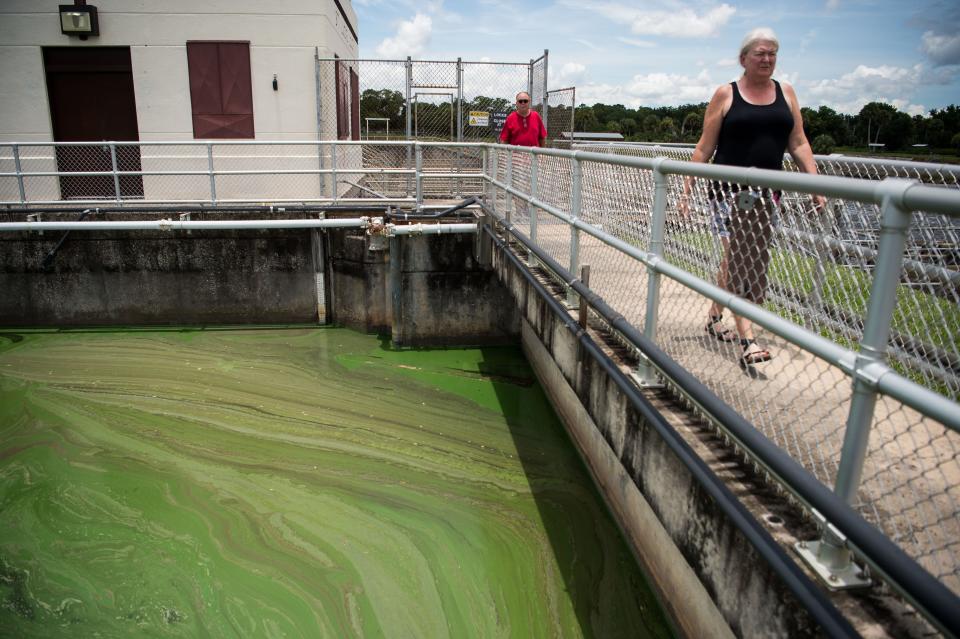Lake O discharges to Stuart will stop April 15, will continue for Caloosahatchee River
Lake Okeechobee discharges to the St. Lucie River will stop April 15, but they will continue to the Caloosahatchee River, the Army Corps of Engineers announced Friday.
That's sooner than expected. The agency previously said discharges could continue into May or June.
Lake O's level had dropped to 14 feet, 2 inches as of Friday, and "will likely get down to 13 feet" by June 1, Lt. Col. Todd Polk said. The lake will continue receding mostly from evaporation when drier conditions return, he said. June 1 is the start of the hurricane season, when the agency wants more room in the lake for storm runoff.
Lake O's level has dropped 1 foot, 10 inches since discharges began 83 days ago. A total of 17.3 billion gallons of lake water has entered the St. Lucie River since Jan. 22, according to Army Corps data.
A total of 23.5 billion gallons of water has entered the C-44 Canal from the lake, but the difference was used by agricultural water consumers along the canal.
Ramp rage: Taxpayers could pay millions and lose Fort Pierce boat ramp to development
Jobs for teens: Jobs for teens: Marine industry professionals introduce students to careers
3rd time's a charm: Army Corps starts Lake Okeechobee discharges to Stuart for third time

Toxic blue-green algae has not been seen at the Corps-controlled dams since March 5. The presence of cyanobacteria caused the Corps to halt discharges for a few days two different times:
Jan. 22: Army Corps started discharging 320 million gallons of Lake O water per day east to the St. Lucie River to lower the lake level to 12 feet, 6 inches ahead of the June 1 hurricane season start
Feb. 22: Florida Department of Health office in Martin County issued a health alert because a water sample tested positive for toxic algae containing 0.62 parts per billion of microcystin. At 8 parts per billion, the toxin makes water too hazardous to touch, ingest or inhale for people, pets and wildlife, according to the Environmental Protection Agency.
Feb. 28: Army Corps suspended discharges and the South Florida Water Management District used a peroxide-based algicide to reduce the toxin's concentration.
March 2: Army Corps resumed discharges at the same rate of 320 million gallons per day
March 5: Army Corps suspended discharges for a second time after Port Mayaca Lock & Dam workers observed toxic algae in the water
March 10: Army Corps resumed discharges at an increased rate of 323 million gallons per day.
April 15: Army Corps stops discharges to St. Lucie River until conditions warrant a change.
Mark Perry, executive director of Florida Oceanographic Society in Stuart agreed with the Corps' decision.
"The Army Corps of Engineers made the right decision in ending the discharges to the St. Lucie Estuary. As we have said since discharges began in January, there is no such thing as non-harmful discharges to our waterways. These discharges could have been avoided entirely if there was adequate capacity in the stormwater treatment areas for Lake Okeechobee water instead of basin runoff from agricultural lands. We encourage the Army Corp of Engineers and the South Florida Water Management District to work together to implement solutions and exercise flexibility so that more water can be sent south to the Everglades where it is needed," Perry said.
Ed Killer is a columnist with TCPalm. Email him at ed.killer@tcpalm.com.
This article originally appeared on Treasure Coast Newspapers: Lake O discharges to Stuart will stop, Army Corps said

